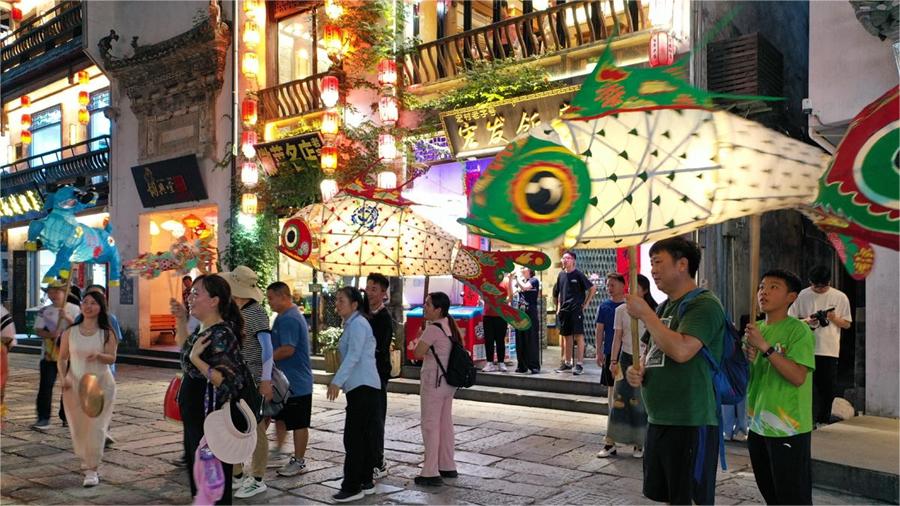Nighttime carnival celebrates Miao culture
A nighttime carnival featuring Miao cuisine, song, dance and traditional clothing at the Chiyou Jiuli Town scenic spot in Chongqing's Pengshui Miao and Tujia autonomous county is attracting visitors from across the country.
Running from late last month to late this month, it features Miao electric music festivals, costume shows, night markets, parades, water-splashing festivals and bonfire parties.
The Miao ethnic group can be traced back to a group living in the eastern plains of China over 7,000 years ago. The group mostly settled in southwestern China, primarily in today's Guizhou, Hunan and Yunnan provinces, from the time of the Tang and Song (618-1279) dynasties.
More than 11 million Miao people are now scattered across nine provinces, municipalities and autonomous regions in southern China, with Guizhou as their main base. Their religious beliefs mainly revolve around nature and ancestor worship.
Miao communities can also be found in Vietnam, Laos, Thailand, Myanmar, the United States, France, Argentina and Australia.
Chiyou Jiuli Town's striking architecture, covering more than 28 hectares and with a total construction area of 110,000 square meters, comprises more than 40 buildings built on a hill. It is China's largest stilt building complex.
"I was immediately captivated by the stunning night view of the architecture here," said Chen Jing, a tourist from Beijing who explored the area on Sunday night.
Located in southeast Chongqing, Pengshui is home to 318,000 Miao people who comprise 45.4 percent of the county's population. It has the largest concentration of Miao people in all ethnic minority counties, according to local authorities.
Named after the ancestor and ancient tribe of the Miao ethnic group, Chiyou Jiuli Town was opened to the public in 2015.
Chiyou, a mythical warrior who was the ancestor of the Miao people and the leader of the ancient Jiuli tribe, is held to be one of the three ancestors of the Chinese nation. Legend has it that Chiyou was a formidable tribal chief who clashed with the Yellow Emperor, or Huangdi, and his ally the Red Emperor, or Yandi, before ultimately being defeated in battle.
"After thousands of years of migration and evolution, the Miao ethnic group has gradually transformed from a native Chinese tribe into a global community," said Chen Lin, deputy director of the county's cultural and tourism committee.
Zhao Guanghui, vice-general manager of Chongqing Jiuli Tourism Holdings Group, said, "Chiyou Jiuli Town has not only become a popular tourist destination, but also a symbol of ethnic identity."
Every year on the eighth day of the fourth lunar month, a Chiyou sacrificial ceremony is held around a stone totem pillar at the scenic spot, attracting people from around the world.
The 24-meter-tall Jiuli Pillar, the tallest such totem, has a base diameter of 3 meters, and is adorned with 108 carved figures, according to Shanghai China Records, a group dedicated to the cataloging and verification of records. The pillar took 30 stonecutting artists more than eight months to complete.
The scenic spot receives roughly 1.5 million visitors a year.
"The number of customers renting ethnic costumes at my store has increased by more than 30 percent recently," said Wu Song, the owner of a shop at the scenic spot that rents Miao costumes to visitors — mostly young women and families with children.
Besides domestic tourists, the scenic spot also attracts many overseas visitors, especially from Southeast Asian countries.
In the first half of this year, tourism arrivals in the county were up 20.8 percent year-on-year and overall tourism revenue was up 24 percent.
Photos
Related Stories
- Miao ethnic group hamlet in China promotes rural vitalization for further development
- Miao ethnic village in SW China preserves ancient traditions
- Miao people celebrate Caihuashan festival in Chongqing
- Time-honored musical instrument echoes melodies from mountains
- Feature: Passing down language without writing system to schoolkids in Miao ethnic village
Copyright © 2024 People's Daily Online. All Rights Reserved.









